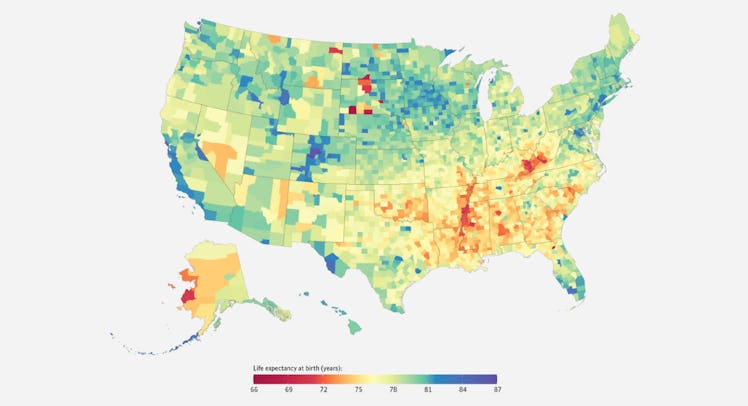Kids Born Today Could See Shorter Lifespans Than Their Parents
Mind the gap.

Parents shouldn’t have longer life expectancies than their children. But for kids born in 13 U.S. counties—many of them concentrated in Kentucky—this is an unfortunate reality, according to a study by the Institute for Health Metrics and Evaluation. The findings suggest that, despite a steady increase in overall life expectancy in the U.S., a handful of American counties have been left behind and even experienced a decrease in average lifespan since 1980. Residents of Oglala Lakota County in South Dakota, for instance, now have lower life expectancies than people living in Sudan.
“The drastically different life expectancies are likely the result of a combination of risk factors, socioeconomics, and access and quality of health care in those areas,” Christopher J.L. Murray, director of the institute and lead author on the study, told CNN. “We can see that many of the counties with very low life expectancies in the Dakotas, like Oglala Lakota County in South Dakota, overlap with large Native American reservations.”
Here’s a map of how life expectancies have changed across individual counties since 1980. While most of the country is living longer (indicated by counties turning blue), isolated counties are experiencing the opposite effect (red):
For the study, published this week in JAMA Internal Medicine, Murray and his team examined death records and population counts from the National Center for Health Statistics, as well as data from the Census Bureau and the Human Mortality Database (all of their data is available here). The highest life expectancies were found in three Colorado counties—Summit County (86.8 years), Pitkin County (86.5), and Eagle County (85.9). Counties with the highest rates of increase in life expectancy since 1980 were largely concentrated in Alaska and New York:
Meanwhile, South Dakota is home to the lowest life expectancies in the country, and counties in West Virginia, Alabama, and several states along the Mississippi River have relatively short life spans as well. But when it comes to decreases in life expectancy since 1980, Kentucky is startling outlier—over the past three decades, eight counties in the state have experienced the most severe lifespan drops in the U.S. “It’s this steady process where many parts of the country have been steadily getting better, and then there’s a segment of America where things have not progressed in a generation and a half,” Murray told NPR. In Kentucky, it seems this “steady progress” is moving in the wrong direction:
One bit of good news: Murray and his colleagues noted a decrease in the risk of children dying before age 5 across the board—likely a result of health programs and services geared towards infants and children. That’s promising, because it suggests that broad public health interventions can work. Comparable measures can be taken in adults in areas such as mental health, especially since past studies have shown a spike in deaths by suicide and overdose since 1980, too.
Absent an intervention, however, the life expectancy gap will likely grow. “With every passing year, inequality—however you measure it—has been widening,” Murray told NPR. “And so next year, we can reliably expect it’ll be even more.”
This article was originally published on